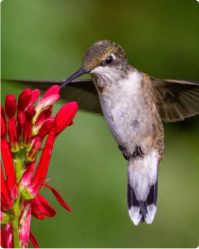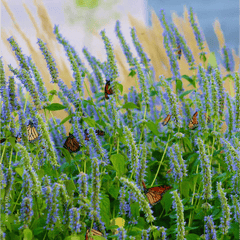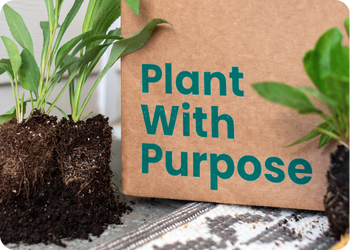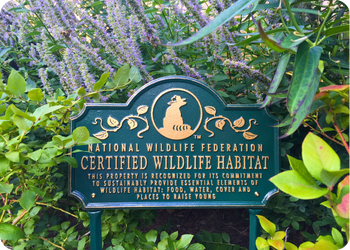Gardening for Liberation: The Legacy of Black Gardeners and Gardens

At Garden for Wildlife, we believe that gardens can change the world. These humble spaces provide refuge for creatures—human, plant, animal—from an often hostile world outside. They also allow one to cultivate a direct relationship with the earth: the things of the garden spring forth from the ground and die back into it, offering up infinite beauty and satiety within a simple, intimate circle of relation. Gardens help us to see differently, to be differently, and thus, often, to recognize the misalignment between the world as it is and the world as it could be. In this and other ways, gardens are powerful political spaces.
This is not a new idea. Black Americans—Black women in particular—have long tended to their gardens as sites of earth care, community care, and political organization.
Gardens were a means of survival for enslaved Africans, who cultivated their own plots under the cover of night. Cultural historian Micheal Twitty refers to these early gardens as “landscapes of resistance,” for they not only served as a source of physical nourishment, but also as a means of cultural preservation. Many of the crops in these gardens, such as okra and black-eyed-peas, were carried by Africans across the Atlantic in the slave ships, sometimes braided into people’s hair for safekeeping. “Every time you say ‘okra,” Twitty says, “you are using a word that was passed down by somebody who said, ‘I cannot forget this word.”

[“Interpretation of a garden built by enslaved people at Williamsburg” by Sarah Stierch is licensed under CC BY 2.0]
The word okra was not forgotten—nor were these landscapes of resistance. The lineage of Black gardening continued throughout the Jim Crow era and beyond, helping Black communities to feed, heal, and celebrate themselves in a country that sought to deny their humanity. With severely limited access to health care, healthy food, and public space, Black people sought to provide these crucial services to their communities through their gardens—cultivating edible and medicinal plants, organizing mutual aid and political movements, and healing in connection with nature. Gardens were important intergenerational spaces as well, facilitating the transmission of both gardening tips and ancestral wisdom.
In the face of segregation and systemic racism, many Southern black women dedicated themselves to their gardens as political statements. This was a space where they could create freely, and, in the words of Alice Walker, be “involved in work her soul must have.” Here is the full quote, from Walker’s book, In Search of Our Mothers’ Gardens:
“I remember people coming to my mother’s yard to be given cuttings from flowers; I hear again the praise showered on her because whatever rocky soil she landed on, she turned into a garden. A garden so brilliant with colors, so original in its design, so magnificent with life and creativity, that to this day people drive by our house in Georgia—perfect strangers and imperfect strangers—and ask to stand or walk amongst my mother’s art. I notice that it is only when my mother is working amongst her flowers that she is radiant, almost to the point of being invisible—except as Creator: hand and eye. She is involved in work her soul must have. Ordering the Universe in the image of her personal conception of Beauty.”

Poet Anne Spencer maintained a glorious blue-latticed garden in her Lynchburg, Virginia home, which served as an outpost of the Harlem Renaissance and a gathering space for leaders like W.E.B. Du Bois, Zora Neale Hurston, Langston Hughes, and Martin Luther King, Jr. She helped to found the Lynchburg chapter of the NAACP as well as the first library open to the city’s Black citizens, where she served as librarian for many years. The magnitude of her civic life was resourced in large part by her garden, which she referred to as “half my world.” Her poem, “For Jim, Easter Eve,” articulates the transformative power of her garden to compost sorrow and generate joy.
What is sorrow but tenderness now in this earth-close frame of land and sky falling constantly into horizons of east and west, north and south; what is pain but happiness here amid these green and wordless patterns,--indefinite texture of blade and leaf.
You can still visit Anne Spencer’s home and garden, which has been lovingly restored to its prime 1930s state by the Hillside Garden Club and is in fact the only known restored garden of an African American in the country.
Beyond opening up space for creativity and cultural expression, Black gardens have also served as nexus points for Black political organizing, from the Civil Rights movement to the current environmental justice and urban agriculture movements. At the onset of the Civil Rights movement, Black garden clubs constituted highly organized communal and political networks, rivaled only in power by that of the Black church, claims horticultural historian Abra Lee. Across the country, Black garden clubs were instrumental in registering Black citizens to vote, as well as creating and caring for community green space in Black neighborhoods.
Phoenix Smith claims that these garden clubs were practicing liberation ecotherapy: caring for their community and the land, connecting directly with the earth to heal and nourish themselves when the indirect provisioning of the state was insufficient or altogether withheld.
“When my Great Aunt was in Black garden groups, they didn’t only talk about collard greens or the best way to prune certain trees, they also said ‘Hey, how can we get people registered to vote?’ That was a social justice act, that was liberation ecotherapy… They were talking about, ‘Hey, I have this pain in my back or my shoulder,’ because there were no doctors that would serve them, and so one or two of the women in the group who knew about the Earth would say, ‘Here honey put this on your hip, put these plants together.’ They were creating medicine for themselves. There wasn't Medicaid or a system of care in Jim Crow Texas for them. This is liberation ecotherapy.”
You can learn more about Liberation Ecotherapy, a healing justice framework that prioritizes earth connection to forward public health and social justice, on this episode of Upstream (quoted above), or at the Alliance for Ecotherapy and Social Justice, which Smith founded.

Today, the garden continues to be a site of community care and organizing in Black neighborhoods living under food apartheid—that is, the deliberate and systemic lack of nutritious and affordable food in communities of color. Initiatives like Soul Fire Farm practice Afro-Indigenous and regenerative agriculture to raise and distribute food to those living under food apartheid, and to “reclaim our collective right to belong to the earth and have agency in the food system.” Leah Penniman, Founding Co-Director of Soul Fire Farm and author of Black Earth Wisdom and Farming While Black, regards the land as the wellspring of physical, cultural and planetary health—wisdom, she claims, that has belonged to Black people since before 51 BCE, when Cleopatra declared earthworms sacred and untouchable in the interest of soil fertility. She sees the work of Soul Fire Farm, and that of other Black earth stewards, as “carrying on the legacy of our ancestral grandmothers, who braided seeds in their hair before boarding transatlantic slave ships, believing against odds in a future of sovereignty on land.”
As social and ecological crises culminate and reveal their shared roots in colonialism, extractivism, and the Western ontological practice of othering, BIPOC leaders like Pinneman, and Smith are drawing on the rich legacy of Black earth care to chart a path toward a more free, more relational future—with the garden at the center. Belief in the power of the backyard garden is also the driving force behind Garden for Wildlife’s theory of change. We owe a debt of gratitude to the Black horticultural tradition and to Black gardeners throughout our country’s history who have cultivated the lineages of gardening for beauty, gardening for community, and gardening for liberation.

Find Native Plants by Zip Code
We took the guesswork out of planting native. Check your zip to see what ships!
















